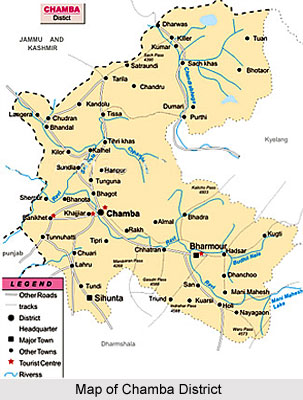 Chamba District is an administrative district of Himachal Pradesh with its headquarters at Chamba town. Chamba District covers an estimated area of 6528 sq kms and is surrounded on all sides by lofty hill ranges. The territory is wholly mountainous with altitude ranging from 2,000 to 21,000 feet. Total population of Chamba District is 460,499 according to Census 2001. The climate of Chamba District ranges from semi-tropical to semi-arctic.
Chamba District is an administrative district of Himachal Pradesh with its headquarters at Chamba town. Chamba District covers an estimated area of 6528 sq kms and is surrounded on all sides by lofty hill ranges. The territory is wholly mountainous with altitude ranging from 2,000 to 21,000 feet. Total population of Chamba District is 460,499 according to Census 2001. The climate of Chamba District ranges from semi-tropical to semi-arctic.
History of Chamba District
The early history of Chamba District says that Kolian tribes inhabited in this region. Later on, it was occupied by the Khasas and they too came under the control of Audumbaras (2nd century BC). Chamba District is one of those princely states of India that were formed during the 6th Century. Mughla rulers did not invade this region. Sikh army invaded the region in around 18th century AD. Later, in the year 1948 Himachal Pradesh was created after merging the principal states of Chamba, Mandi-Suket and Sirmour.
Geography of Chamba District
Chamba District is situated between 32 degree 11 minutes 30 seconds and 33 degree 13 minutes 6 seconds north latitude and 75 degree 49 minutes and 77 degree 3 minutes 30 seconds east longitude. Chamba District is bounded on north-west by Jammu and Kashmir, on the north-east and east by Ladakh and Lahul and Bara-Bangal area, on the south-east and south by Kangra and Gurdaspur District of Punjab.
Tourism in Chamba District
Chamba District is known for its various temples as well as some historic sites. It is one of the popular tourist sites of the state. The main attractions of Chamba District include Laxmi Narayan Temple, Champavati Temple, Chamunda Devi Temple, Vajreshvari Temple, Bansi Gopal Temple, Hari Rai Temple, Bhader Kali Temple, Vishnu Temple, Manimahesh Temple, Ardha Gaya, Rang Mahal, Akhand Chandi Palace, Bhuri Singh Museum, Rock Garden, Art Garden, Chhatrari Devi Temple and Chandershekhar Temple. These places are worth visiting.
No other district in Himachal Pradesh provides as diverse variety of arts, crafts, folk dances and cultural traditions as Chamba District does.
This article is a stub. You can enrich by adding more information to it. Send your Write Up to content@indianetzone.com






